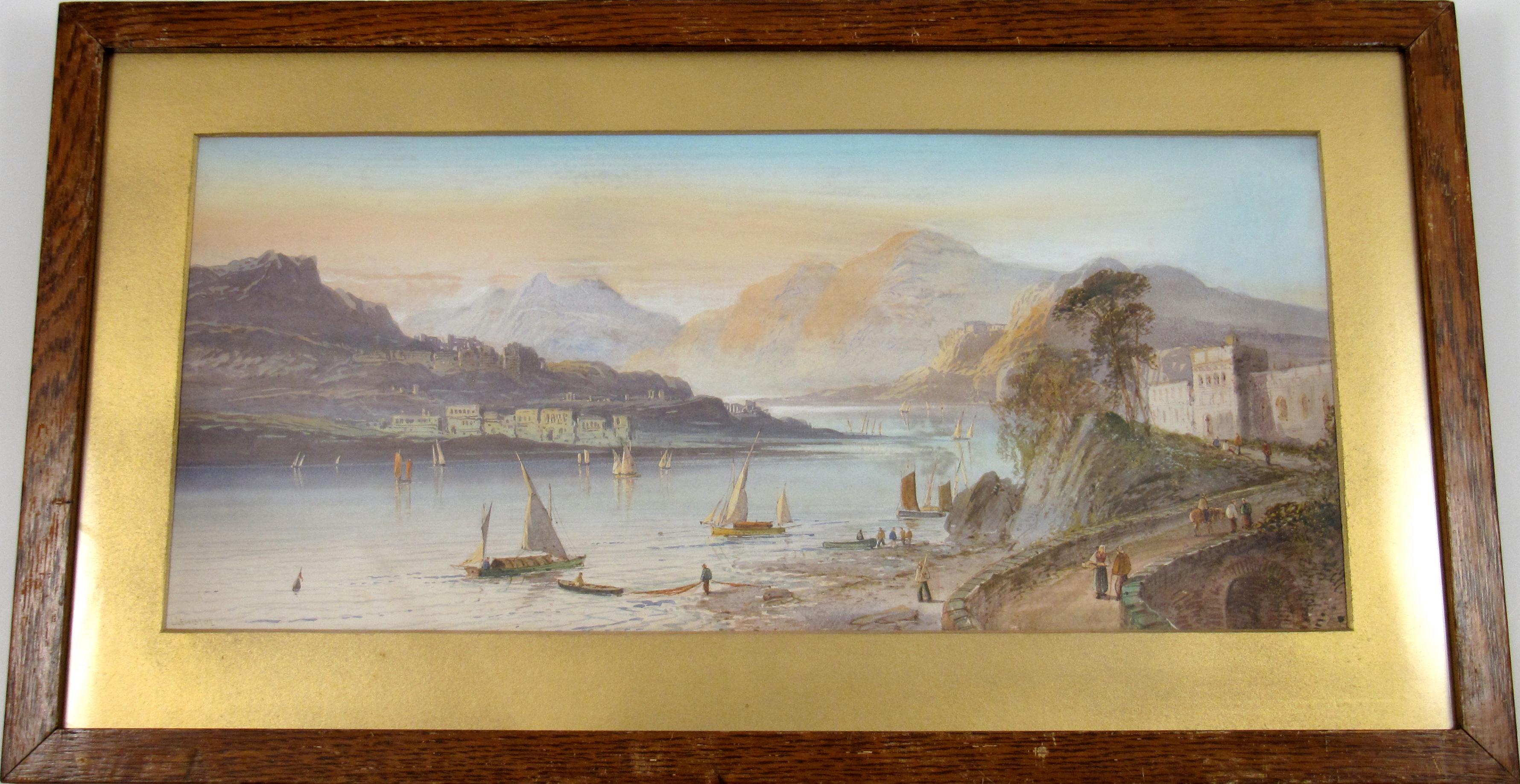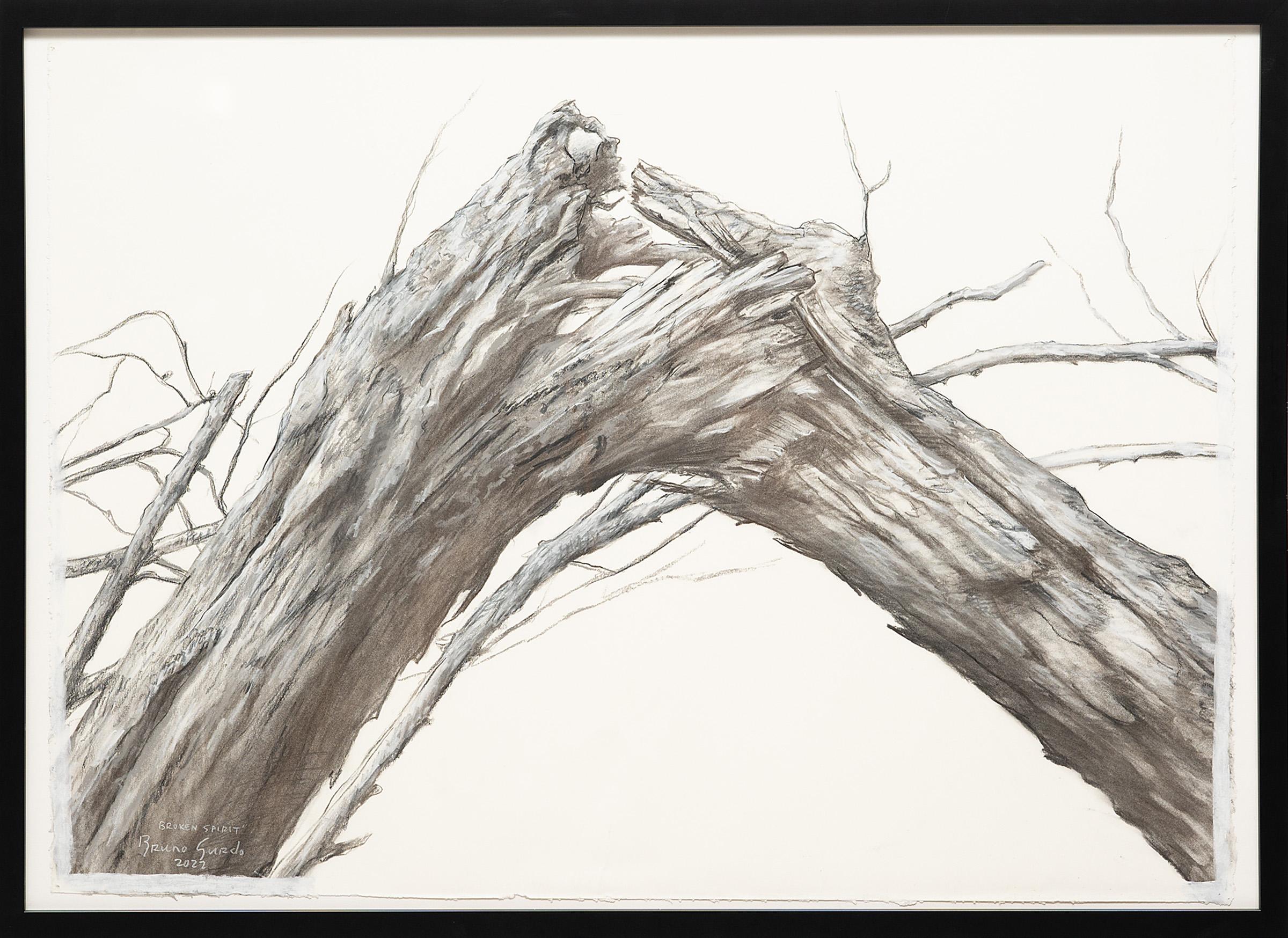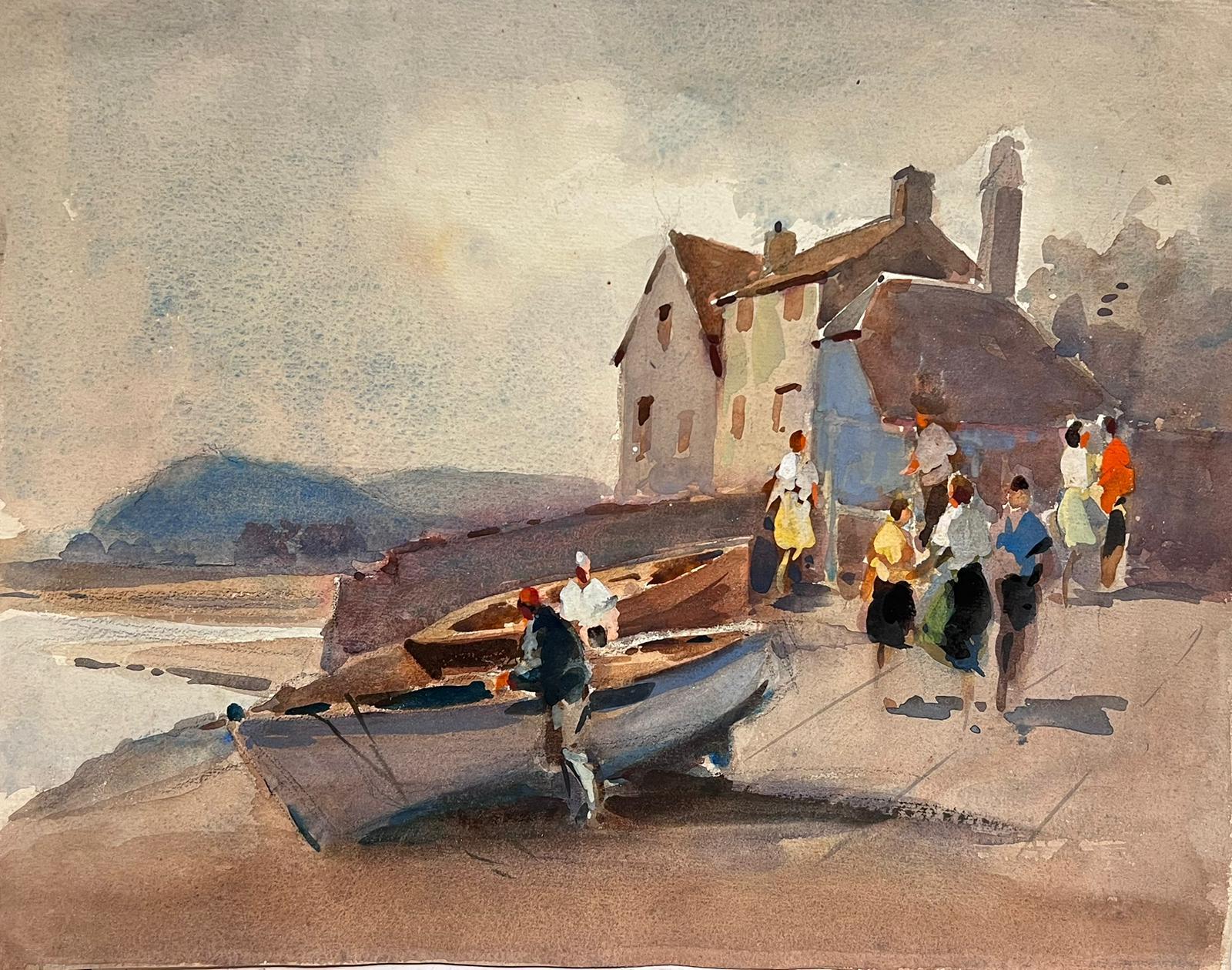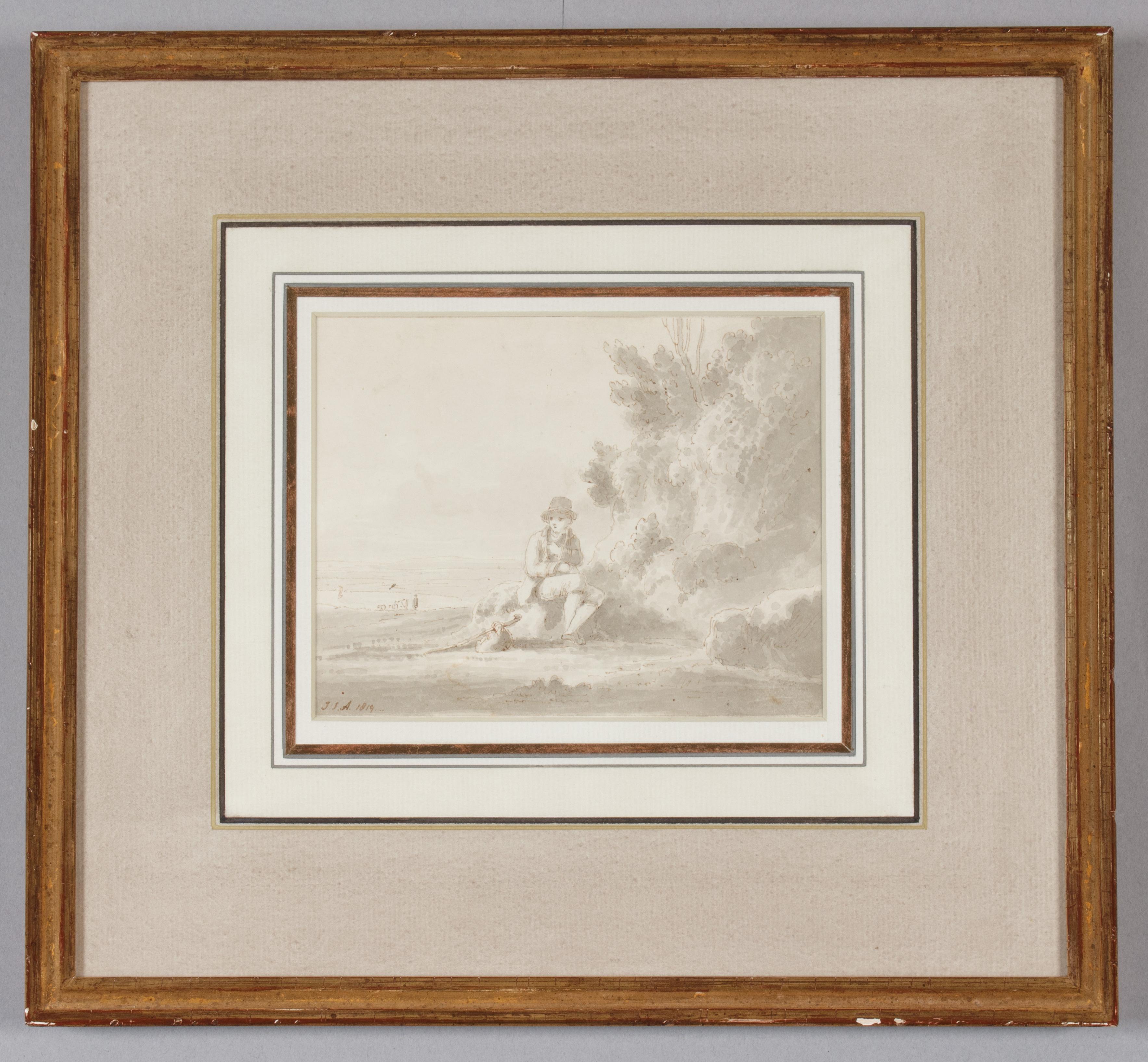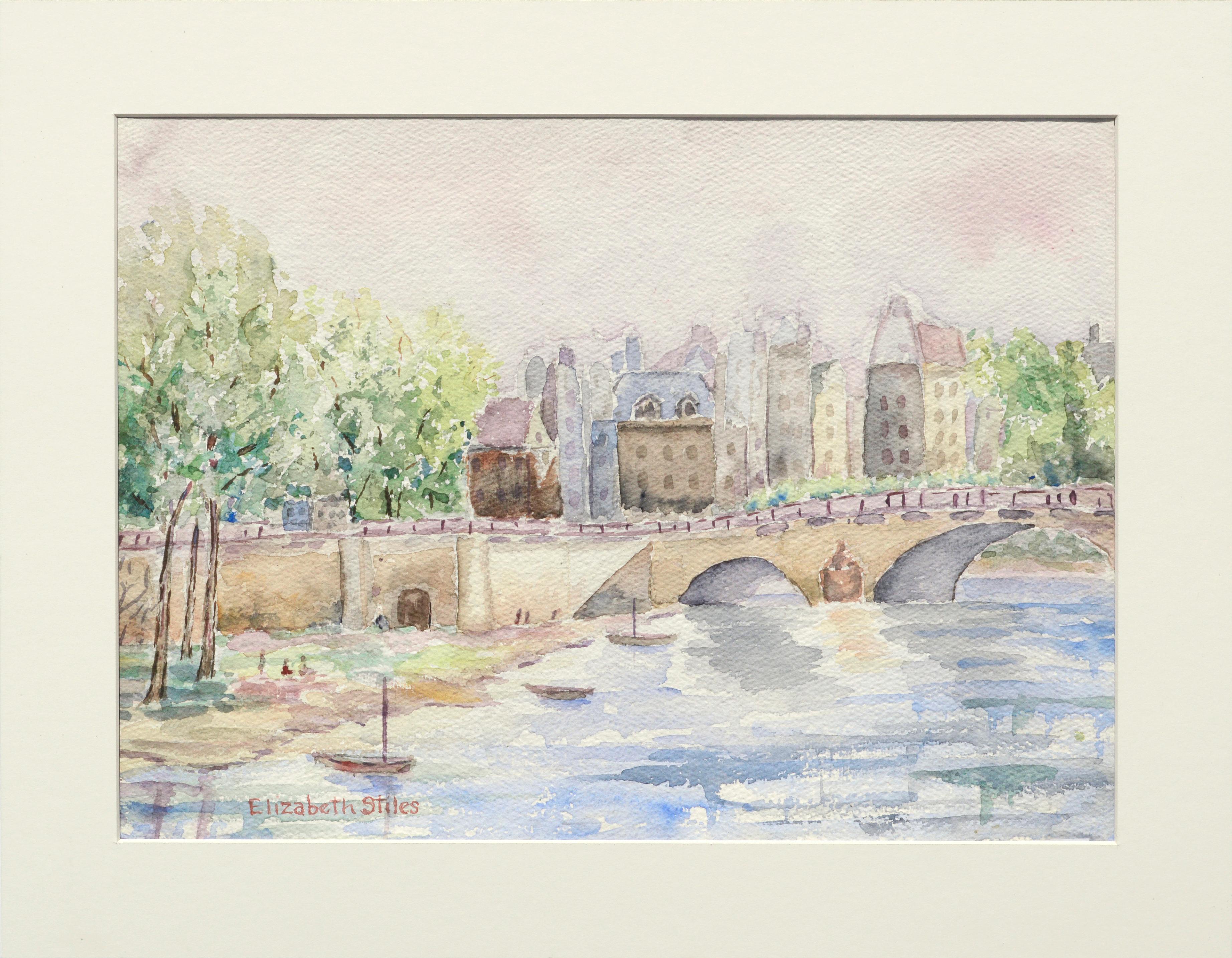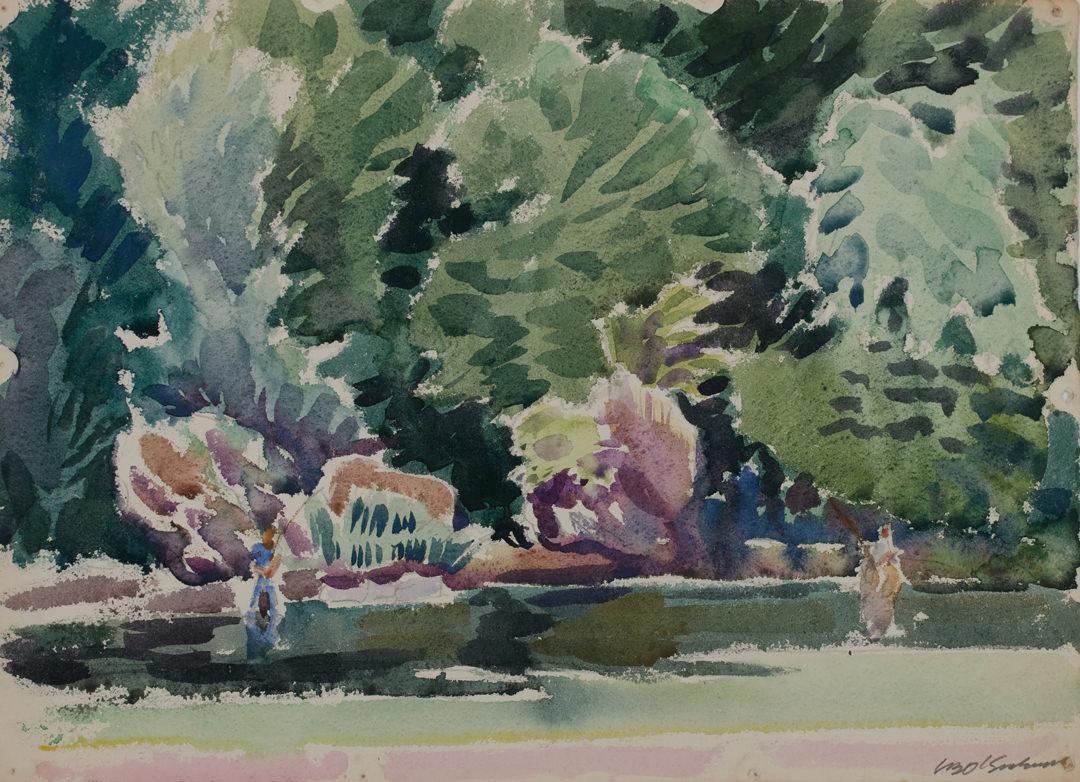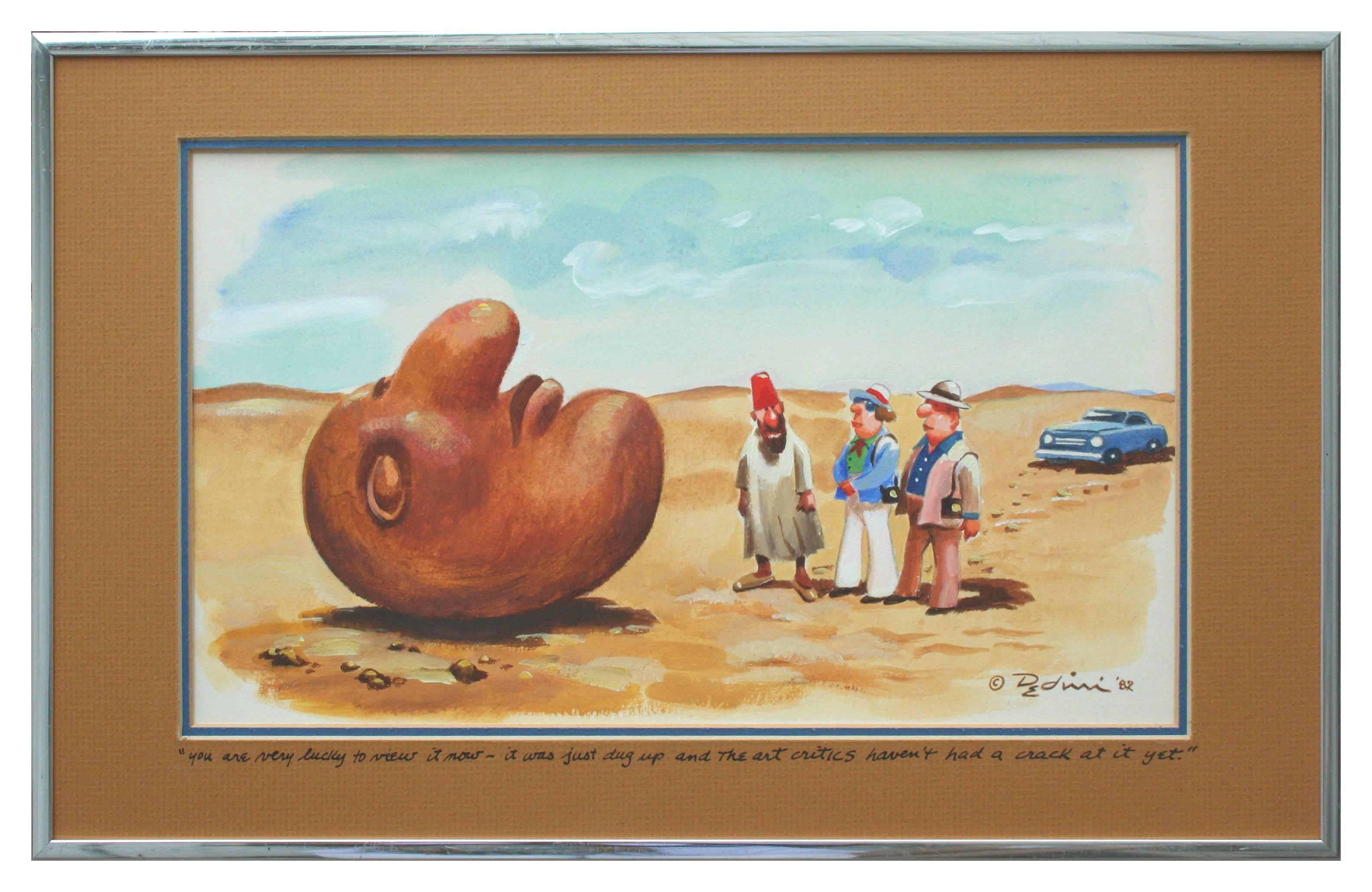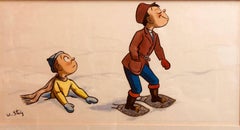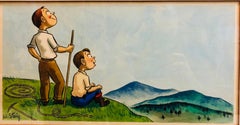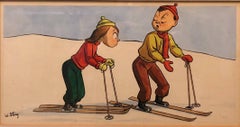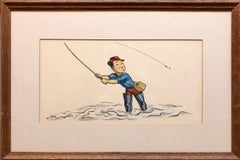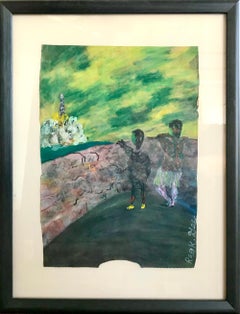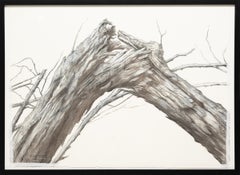
Rare Israeli Reuven Rubin watercolor painting Bezalel school
View Similar Items
Want more images or videos?
Request additional images or videos from the seller
1 of 9
Reuven RubinRare Israeli Reuven Rubin watercolor painting Bezalel school
About the Item
- Creator:Reuven Rubin (1893 - 1974, Israeli)
- Dimensions:Height: 36 in (91.44 cm)Width: 25.5 in (64.77 cm)
- Period:
- Condition:excellent. frame with some minor loss to gilding minor wear and tear.
- Gallery Location:Surfside, FL
- Reference Number:1stDibs: G14030538213
Reuven Rubin
Reuven Rubin- (November 13, 1893 - October 13, 1974) was a Romanian-born Israeli painter and Israel's first ambassador to Romania. Rubin Zelicovici (later Reuven Rubin) was born in Galaţi to a poor Romanian Jewish Hasidic family. He was the eighth of 13 children. In 1912, he left for Ottoman-ruled Palestine to study art at Bezalel Academy of Art and Design in Jerusalem. Finding himself at odds with the artistic views of the Academy's teachers, he left for Paris, France, in 1913 to pursue his studies at the École Nationale Supérieure des Beaux-Arts. At the outbreak of World War I, he was returned to Romania, where he spent the war years.
In 1921, he traveled to the United States with his friend and fellow artist, Arthur Kolnik, with whom he had shared a studio in Cernăuţi. In New York City, the two met artist Alfred Stieglitz, who was instrumental in organizing their first American show at the Anderson Gallery. Following the exhibition, in 1922, they both returned to Europe. In 1923, Rubin emigrated to Mandate Palestine.
Rubin met his wife, Esther, in 1928, aboard a passenger ship to Palestine on his return from a show in New York. She was a Bronx girl who had won a trip to Palestine in a Young Judea competition. He died in 1974.
About the Seller
4.9
Platinum Seller
These expertly vetted sellers are 1stDibs' most experienced sellers and are rated highest by our customers.
Established in 1995
1stDibs seller since 2014
1,591 sales on 1stDibs
Typical response time: 1 hour
Authenticity Guarantee
In the unlikely event there’s an issue with an item’s authenticity, contact us within 1 year for a full refund. DetailsMoney-Back Guarantee
If your item is not as described, is damaged in transit, or does not arrive, contact us within 7 days for a full refund. Details24-Hour Cancellation
You have a 24-hour grace period in which to reconsider your purchase, with no questions asked.Vetted Professional Sellers
Our world-class sellers must adhere to strict standards for service and quality, maintaining the integrity of our listings.Price-Match Guarantee
If you find that a seller listed the same item for a lower price elsewhere, we’ll match it.Trusted Global Delivery
Our best-in-class carrier network provides specialized shipping options worldwide, including custom delivery.More From This Seller
View AllWhimsical Illustration "Snow" Cartoon, 1938 Mt Tremblant Ski Lodge William Steig
By William Steig (b.1907)
Located in Surfside, FL
Lighthearted Illustration of Outdoor Pursuits This one being cross country Snow Shoes signed "W. Steig"
Provenance: from Mrs. Joseph B. Ryan, Commissioned by ...
Category
1930s American Modern Figurative Drawings and Watercolors
Materials
India Ink, Watercolor, Illustration Board
Whimsical Illustration Hiking Cartoon, 1938 Mt Tremblant Ski Lodge William Steig
By William Steig (b.1907)
Located in Surfside, FL
Lighthearted Illustration of Outdoor Pursuits This one being cross country hiking signed "W. Steig"
Provenance: from Mrs. Joseph B. Ryan, Commissioned by Joe Ryan for the bar at his ski resort, Mount Tremblant Lodge, in 1938.
Mont Tremblant, P.Q., Canada
Watercolor and ink on illustration board, sights sizes 8 1/2 x 16 1/2 in., framed.
In 1938 Joe Ryan, described as a millionaire from Philadelphia, bushwhacked his way to the summit of Mont Tremblant and was inspired to create a world class ski resort at the site. In 1939 he opened the Mont Tremblant Lodge, which remains part of the Pedestrian Village today. This original illustration is on Whatman Illustration board. the board measures 14 X 22 inches. label from McClees Galleries, Philadelphia, on the frame backing paper.
William Steig, 1907 – 2003 was an American cartoonist, sculptor, and, in his later life, an illustrator and writer of children's books. Best known for the picture books Sylvester and the Magic Pebble, Abel's Island, and Doctor De Soto, he was also the creator of Shrek!, which inspired the film series of the same name. He was the U.S. nominee for both of the biennial, international Hans Christian Andersen Awards, as a children's book illustrator in 1982 and a writer in 1988.
Steig was born in Brooklyn, New York in 1907, and grew up in the Bronx. His parents were Polish-Jewish immigrants from Austria, both socialists. His father, Joseph Steig, was a house painter, and his mother, Laura Ebel Steig, was a seamstress who encouraged his artistic leanings. As a child, he dabbled in painting and was an avid reader of literature. Among other works, he was said to have been especially fascinated by Pinocchio.He graduated from Townsend Harris High School at 15 but never completed college, though he attended three, spending two years at City College of New York, three years at the National Academy of Design and a mere five days at the Yale School of Fine Arts before dropping out of each.
Hailed as the "King of Cartoons" Steig began drawing illustrations and cartoons for The New Yorker in 1930, producing more than 2,600 drawings and 117 covers for the magazine. Steig, later, when he was 61, began writing children's books. In 1968, he wrote his first children's book. He excelled here as well, and his third book, Sylvester and the Magic Pebble (1969), won the Caldecott Medal. He went on to write more than 30 children's books, including the Doctor DeSoto series, and he continued to write into his nineties. Among his other well-known works, the picture book Shrek! (1990) formed the basis for the DreamWorks Animation film Shrek (2001). After the release of Shrek 2 in 2004, Steig became the first sole-creator of an animated movie franchise that went on to generate over $1 billion from theatrical and ancillary markets after only one sequel. Along with Maurice Sendak, Saul Steinberg, Ludwig Bemelmans and Laurent de Brunhofff his is one of those rare cartoonist whose works form part of our collective cultural heritage.
In 1984, Steig's film adaptation of Doctor DeSoto directed by Michael Sporn was nominated for the Academy Award for Best Animated Short Film. As one of the most admired cartoonists of all time, Steig spent seven decades drawing for the New Yorker magazine. He touched generations of readers with his tongue–in–cheek pen–and–ink drawings, which often expressed states of mind like shame, embarrassment or anger. Later in life, Steig turned to children's books, working as both a writer and illustrator.
Steig's children's books were also wildly popular because of the crazy, complicated language he used—words like lunatic, palsied, sequestration, and cleave. Kids love the sound of those words even if they do not quite understand the meaning. Steig's descriptions were also clever. He once described a beached whale as "breaded with sand."
Throughout the course of his career, Steig compiled his cartoons and drawings into books. Some of them were published first in the New Yorker. Others were deemed too dark to be printed there. Most of these collections centered on the cold, dark psychoanalytical truth about relationships. They featured husbands and wives fighting and parents snapping at their kids. His first adult book, Man About Town, was published in 1932, followed by About People, published in 1939, which focused on social outsiders. Sick of Each Other, published in 2000, included a drawing depicting a wife holding her husband at gunpoint, saying, "Say you adore me."
According to the Los Angeles Times, fellow New Yorker artist Edward Sorel...
Category
1930s Naturalistic Figurative Drawings and Watercolors
Materials
Archival Ink, Watercolor, Illustration Board
Whimsical Illustration Skiing Cartoon, 1938 Mt Tremblant Ski Lodge William Steig
By William Steig (b.1907)
Located in Surfside, FL
Lighthearted Illustration of Outdoor Pursuits This one being a Skiing scene, a boy and a girl on skis. signed W. Steig
Provenance: from Mrs. Joseph B. Ryan, Commissioned by Joe Ryan for the bar at his ski resort, Mount Tremblant Lodge, in 1938.
Mont Tremblant, P.Q., Canada
Watercolor and ink on illustration board, sights sizes 8 1/2 x 16 1/2 in., framed.
In 1938 Joe Ryan, described as a millionaire from Philadelphia, bushwhacked his way to the summit of Mont Tremblant and was inspired to create a world class ski resort at the site. In 1939 he opened the Mont Tremblant Lodge, which remains part of the Pedestrian Village today. This original illustration is on Whatman Illustration board. the board measures 14 X 22 inches. label from McClees Galleries, Philadelphia, on the frame backing paper.
William Steig, 1907 – 2003 was an American cartoonist, sculptor, and, in his later life, an illustrator and writer of children's books. Best known for the picture books Sylvester and the Magic Pebble, Abel's Island, and Doctor De Soto, he was also the creator of Shrek!, which inspired the film series of the same name. He was the U.S. nominee for both of the biennial, international Hans Christian Andersen Awards, as a children's book illustrator in 1982 and a writer in 1988.
Steig was born in Brooklyn, New York in 1907, and grew up in the Bronx. His parents were Polish-Jewish immigrants from Austria, both socialists. His father, Joseph Steig, was a house painter, and his mother, Laura Ebel Steig, was a seamstress who encouraged his artistic leanings. As a child, he dabbled in painting and was an avid reader of literature. Among other works, he was said to have been especially fascinated by Pinocchio.He graduated from Townsend Harris High School at 15 but never completed college, though he attended three, spending two years at City College of New York, three years at the National Academy of Design and a mere five days at the Yale School of Fine Arts before dropping out of each.
Hailed as the "King of Cartoons" Steig began drawing illustrations and cartoons for The New Yorker in 1930, producing more than 2,600 drawings and 117 covers for the magazine. Steig, later, when he was 61, began writing children's books. In 1968, he wrote his first children's book. He excelled here as well, and his third book, Sylvester and the Magic Pebble (1969), won the Caldecott Medal. He went on to write more than 30 children's books, including the Doctor DeSoto series, and he continued to write into his nineties. Among his other well-known works, the picture book Shrek! (1990) formed the basis for the DreamWorks Animation film Shrek (2001). After the release of Shrek 2 in 2004, Steig became the first sole-creator of an animated movie franchise that went on to generate over $1 billion from theatrical and ancillary markets after only one sequel. Along with Maurice Sendak, Saul Steinberg, Ludwig Bemelmans and Laurent de Brunhofff his is one of those rare cartoonist whose works form part of our collective cultural heritage.
In 1984, Steig's film adaptation of Doctor DeSoto directed by Michael Sporn was nominated for the Academy Award for Best Animated Short Film. As one of the most admired cartoonists of all time, Steig spent seven decades drawing for the New Yorker magazine. He touched generations of readers with his tongue–in–cheek pen–and–ink drawings, which often expressed states of mind like shame, embarrassment or anger. Later in life, Steig turned to children's books, working as both a writer and illustrator.
Steig's children's books were also wildly popular because of the crazy, complicated language he used—words like lunatic, palsied, sequestration, and cleave. Kids love the sound of those words even if they do not quite understand the meaning. Steig's descriptions were also clever. He once described a beached whale as "breaded with sand."
Throughout the course of his career, Steig compiled his cartoons and drawings into books. Some of them were published first in the New Yorker. Others were deemed too dark to be printed there. Most of these collections centered on the cold, dark psychoanalytical truth about relationships. They featured husbands and wives fighting and parents snapping at their kids. His first adult book, Man About Town, was published in 1932, followed by About People, published in 1939, which focused on social outsiders. Sick of Each Other, published in 2000, included a drawing depicting a wife holding her husband at gunpoint, saying, "Say you adore me."
According to the Los Angeles Times, fellow New Yorker artist Edward Sorel...
Category
1930s Naturalistic Figurative Drawings and Watercolors
Materials
Archival Ink, Watercolor, Illustration Board
Whimsical Fishing Illustration Cartoon 1938 Mt Tremblant Ski Lodge William Steig
By William Steig (b.1907)
Located in Surfside, FL
Lighthearted Illustration of Outdoor Pursuits This one of a fisherman signed "W. Steig"
Provenance: from Mrs. Joseph B. Ryan, Commissioned by Joe Ryan for the bar at his ski resort, Mount Tremblant Lodge, in 1938.
Mont Tremblant, P.Q., Canada
Watercolor and ink on illustration board, sights sizes 8 1/2 x 16 1/2 in., framed.
In 1938 Joe Ryan, described as a millionaire from Philadelphia, bushwhacked his way to the summit of Mont Tremblant and was inspired to create a world class ski resort at the site. In 1939 he opened the Mont Tremblant Lodge, which remains part of the Pedestrian Village today. This original illustration is on Whatman Illustration board. the board measures 14 X 22 inches. label from McClees Galleries, Philadelphia, on the frame backing paper.
William Steig, 1907 – 2003 was an American cartoonist, sculptor, and, in his later life, an illustrator and writer of children's books. Best known for the picture books Sylvester and the Magic Pebble, Abel's Island, and Doctor De Soto, he was also the creator of Shrek!, which inspired the film series of the same name. He was the U.S. nominee for both of the biennial, international Hans Christian Andersen Awards, as a children's book illustrator in 1982 and a writer in 1988.
Steig was born in Brooklyn, New York in 1907, and grew up in the Bronx. His parents were Polish-Jewish immigrants from Austria, both socialists. His father, Joseph Steig, was a house painter, and his mother, Laura Ebel Steig, was a seamstress who encouraged his artistic leanings. As a child, he dabbled in painting and was an avid reader of literature. Among other works, he was said to have been especially fascinated by Pinocchio.He graduated from Townsend Harris High School at 15 but never completed college, though he attended three, spending two years at City College of New York, three years at the National Academy of Design and a mere five days at the Yale School of Fine Arts before dropping out of each.
Hailed as the "King of Cartoons" Steig began drawing illustrations and cartoons for The New Yorker in 1930, producing more than 2,600 drawings and 117 covers for the magazine. Steig, later, when he was 61, began writing children's books. In 1968, he wrote his first children's book. He excelled here as well, and his third book, Sylvester and the Magic Pebble (1969), won the Caldecott Medal. He went on to write more than 30 children's books, including the Doctor DeSoto series, and he continued to write into his nineties. Among his other well-known works, the picture book Shrek! (1990) formed the basis for the DreamWorks Animation film Shrek (2001). After the release of Shrek 2 in 2004, Steig became the first sole-creator of an animated movie franchise that went on to generate over $1 billion from theatrical and ancillary markets after only one sequel. Along with Maurice Sendak, Saul Steinberg, Ludwig Bemelmans and Laurent de Brunhofff his is one of those rare cartoonist whose works form part of our collective cultural heritage.
In 1984, Steig's film adaptation of Doctor DeSoto directed by Michael Sporn was nominated for the Academy Award for Best Animated Short Film. As one of the most admired cartoonists of all time, Steig spent seven decades drawing for the New Yorker magazine. He touched generations of readers with his tongue–in–cheek pen–and–ink drawings, which often expressed states of mind like shame, embarrassment or anger. Later in life, Steig turned to children's books, working as both a writer and illustrator.
Steig's children's books were also wildly popular because of the crazy, complicated language he used—words like lunatic, palsied, sequestration, and cleave. Kids love the sound of those words even if they do not quite understand the meaning. Steig's descriptions were also clever. He once described a beached whale as "breaded with sand."
Throughout the course of his career, Steig compiled his cartoons and drawings into books. Some of them were published first in the New Yorker. Others were deemed too dark to be printed there. Most of these collections centered on the cold, dark psychoanalytical truth about relationships. They featured husbands and wives fighting and parents snapping at their kids. His first adult book, Man About Town, was published in 1932, followed by About People, published in 1939, which focused on social outsiders. Sick of Each Other, published in 2000, included a drawing depicting a wife holding her husband at gunpoint, saying, "Say you adore me."
According to the Los Angeles Times, fellow New Yorker artist...
Category
1930s American Modern Figurative Drawings and Watercolors
Materials
India Ink, Watercolor, Illustration Board
Modernist Conte Crayon Drawing Beach Scene David Burliuk Russian Futurist
By David Burliuk
Located in Surfside, FL
David Burliuk (Ukrainian, 1882-1967)
Three figure on the beach (Hamptons, Long Island New York)
Conte crayon drawing on paper.
Hand signed lower left.
Unframed
Provenance: Bloomsbury Auctions
David Davidovich Burliuk (Дави́д Дави́дович Бурлю́к; 1882-1967) was a Russian poet, artist and publicist of Ukrainian origin associated with the Futurist and Neo-Primitivist movements. Burliuk has been described as "the father of Russian Futurism."
David Burliuk was born on 21 July 1882 in the village of Riabushky (near Lebedyn, Ukraine) in the Kharkov Governorate of the Russian Empire. Burliuk's family was artistically inclined; two of his brothers were talented artists as well, Nikolai and Volodimir Burliuk. The Burliuk family partly descended from Ukrainian Cossacks on their father's side, who held premier positions in the Hetmanate. His mother, Ludmyla Mikhnevich, was of ethnic Belarusian descent.
From 1898 to 1904, he studied at Kazan and Odesa art schools, as well as at the Royal Academy in Munich. His exuberant, extroverted character was recognized by Anton Azhbe, his professor at the Munich Academy, who called Burliuk a "wonderful wild steppe horse". During a time of significant industrialization and political change, movements such as the famed Der Blaue Reiter, a group Burliuk associated with in 1912, while he was in Munich, emphasized a shift away from the classical styles of the past, prioritizing the innovations of the future.
In 1907, he made contact with the Russian art world; he met and befriended Mikhail Larionov, and they are both credited as being major forces in bringing together the contemporary art world. In 1908, an exhibition with the group Zveno ("The Link") in Kiev was organized by David Burliuk together with Wladimir Baranoff-Rossine, Alexander Bogomazov, his brother Volodymyr (Wladimir) Burliuk and Aleksandra Exter. The exhibition was a flop, especially because they were all unknown painters. The Burliuks and Larionov left for the aforementioned brothers' home in Chernianka, also known as Hylea; it was during this stay that their work became more Avant-Garde. That autumn, while visiting Ekster, they organized an exhibition which took place in the street; it was a success, and enough money was raised to go to Moscow.
In 1909, Burliuk painted a portrait of his future wife, Marussia, on a background of flowers and rocks...
Category
Mid-20th Century American Modern Figurative Drawings and Watercolors
Materials
Paper, Conté, Crayon
Woodblock Print Polish Israeli Artist Azriel Awret Rainy Street Jerusalem Israel
By Irene Awret
Located in Surfside, FL
Awret, Azriel (Polish Israeli, 1910-2010),
Rainy Street in Jerusalem,
Woodblock print, 9.75 x 7.5 inches, pencil hand signed and numbered 35/60, framed measuring 19.5 x 14.25 inches.
Azriel Awret was born in Lodz, Poland, and moved to Belgium where he lived in Brussels. He married an Aryan woman, Anna Louisa Bonhiere, which saved him from deportation. But in January 1943 he was interned in Malines camp. Awret was an engineer, so he was given employment as an electrician. While in Malines he met Irène Spicker, who was working in the Mahlerstube (art workshop). They married after the war and moved to Israel, settling in Safed and continuing their artistic activity. Today they divide their time between Israel and the United States.
The Beit Lohamei Haghetaot (The Ghetto Fighters’ House Museum) art collection includes works by Awret from his time in Malines. These works depict various aspects of life in Malines, including figures of internees. They were donated by the artist.
He collaborated with his wife in a naif, folk art style.
Irène Awret...
Category
1950s Expressionist Figurative Drawings and Watercolors
Materials
Woodcut
You May Also Like
Lennard Lewis (English, 1826 - 1913) Lago Maggiore Switzerland Water Colour 1898
By Lennard Lewis
Located in Meinisberg, CH
Lennard Lewis
(British, 1826 - 1913)
View of the Lago Maggiore and the Mountains of southern Switzerland
• Water colour on paper
• Signed and dated low...
Category
1890s Victorian Landscape Drawings and Watercolors
Materials
Paper, Watercolor
ROCKET LAUNCH Signed Oil Pastel, Abstract Landscape, Space Travel, Visionary Art
By Reginald K. Gee
Located in Union City, NJ
ROCKET LAUNCH is an original oil pastel drawing on brown paper grocery bag by the self taught African American artist Reginald K. Gee, born April 28, 196...
Category
1990s Neo-Expressionist Figurative Drawings and Watercolors
Materials
Oil Pastel
"Hanging Scroll of Prunus Branches, " Ink on Paper
Located in Chicago, IL
Chinese scholars used natural imagery and scenery to aid in contemplation within the walls of their studios. The complex beauty inherent to landscapes and natural forms inspired clea...
Category
19th Century Qing Figurative Drawings and Watercolors
Materials
Paper, Ink
"Broken Spirit, " Charcoal on Paper
By Bruno Surdo
Located in Chicago, IL
Chicago-based fine art painter Bruno A. Surdo is classically trained in drawing and oil painting in the tradition of Renaissance masters. With strong command of the human form, Surdo...
Category
21st Century and Contemporary Naturalistic Figurative Drawings and Water...
Materials
Paper, Charcoal
British Mid 20th Century Impressionist Painting Busy Figures By Rowing Boats
Located in Cirencester, Gloucestershire
Frank Duffield (British, 1908-1982)
original gouache painting on artist paper, unframed
size: 12 x 15 inches
condition: overall very good, minor wear to the edges as is normal for an unframed work, minor staining from age/ light to the surface
provenance: from a large private collection of this artists work in the UK.
The artist:
Born in Warwick in 1901, Duffield came to Bristol at the age of 23 as an artist at the studio of Mardon Son and Hall. He worked as an illustrator producing designs for cigarette cards, remaining with the company for 37 years until his retirement. He was elected an Artist Member of the Bristol Savages...
Category
Mid-20th Century Impressionist Landscape Drawings and Watercolors
Materials
Gouache
Charles George Nicholls - Watercolour 1805 - Palace on the Ganges, Anglo - India
By Charles George Nicholls
Located in Meinisberg, CH
Charles George Nicholls
(English, flourished 1792 - 1818)
Picturesque Gangetic Landscape in India
• Circa 1805
• Watercolour on thick paper, ca. 20 x 49.5 cm
• Mounted behind a modern passpartout, visible image ca. 19 x 49 cm
• Original Georgian frame (newly glassed) , ca. 39 x 70 cm
• Signed lower left corner
Worldwide shipping is complimentary - There are no additional charges for handling & delivery.
Very detailed watercolor painting - note how light reflecting off the water surface was skillfully created by scratching the paper surface.
Charles G(J)eorge Nicholls, originally a merchant seaman, was a contemporary of Thomas and William Daniell, and like them, he made several sketching trips whilst in India, including up the Dohab, which is from where this drawing appears to be of.
He worked as draughtsman for the East India Company based in Calcutta and was also employed by the Office of the Surveyor-General, where he was involved in the Survey of Orissa, South Bengal.
Unfortunately bad eyesight truncated his career and he returned to England in 1815.
Nicholls signed his middle name’George’ using a ‘G’, aswell as a ‘J.’
Nicholl’s work surfaces from time to time and can command high prices at auction – especially for his Indian landscapes. For example, a drawing by Nicholls ( a page of an album) was auctioned by Sotheby's (Valuable Printed Books, June 1997, Lot 407), or a series of water coulours were auctioned by Christie's (Visions of India, June 1998) and in September 2000 two small drawings were auctioned again by Christie's (Exploration & Travel with Visions of India). Also, I know there is a unsigned water colour titled 'Bridge over the River Bama by Benares' in the collection of the Oriental & India Office Collections (OICO) at the British Library.
Here is a rare opportunity, to acquire a large format watercolor (double album page), featuring a very impressive view of what India looked like over 200 years ago - seen through the eyes of a skilled artist, in employment by the famous East India Company.
I also think that as India opens up more and more rapidly to the world and enjoys increasing prosperity, the interest in cultural heritage, trophy objects like the one I am offering here today, will find their way back to India, into a collection or onto a wall in a chic office or luxurious apartment.
Regarding value ... compare this recent public sale:
Dusasumade Gaut, Bernares by Thomas & William DANIELL (XVIII-XIX)
(Watercolour, Lot # 83, Hammer: € 284,293, 12th June 2024, Dreweatts 1759, United Kingdom)
The water colour drawing...
Category
Early 1800s Naturalistic Landscape Drawings and Watercolors
Materials
Watercolor, Paper
Recently Viewed
View AllMore Ways To Browse
Jerusalem Market
Jewish Yemenite
Galilee Painting
Vintage Baby Girl
French Market Basket
Vintage Native American Baskets
Naive Painting Girl
Baby Bath
Vintage Theater Backdrop
Arab Girl
Mother Holding Baby
Ottoman Auction
Joseph Zaritsky
Vintage Baby Basket
Vintage Baby Bath
PEDRO BARRIOS On Sale
Peregrine Honig On Sale
Phil Shaw
